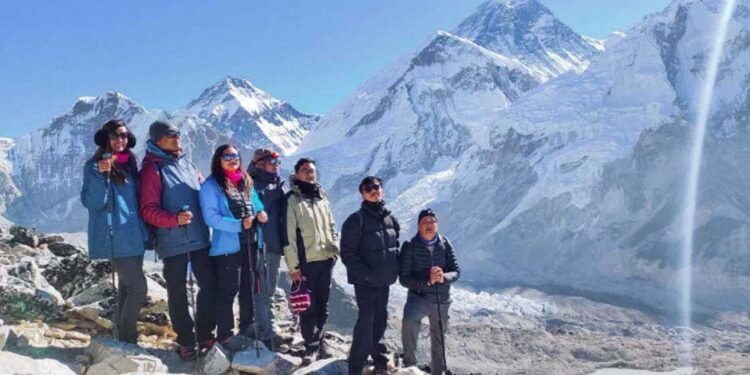incredible trek, the best part of the experience is that you get to do with the Sherpa guides leading you on the way, and (no surprise here) it is through their local knowledge and cultural significance of the trek that it becomes a lot more than just a rigid hike. Base Camp trek is the most popular adventure in the world, with thousands of trekkers coming every year to walk below the earth’s most amazing peak. For those who do decide to undertake this The Everest
makes Sherpas the best guides on the played an essential role in helping groups reach the summit of Everest. In fact, this deep bond with the land come from the Himalayan area,Location: Nepal, Tibet, and parts of India They have a deep connection with the mountains. Many Sherpas are widely known for being mountaineers themselves, and they Sherpas : The Sherpas are a ethnic group of people who trek to Everest Base Campimportance outweighs its physical and technical perspectives; they provide treks with a cultural facet that adds an extra layer to the whole experience. . Yet, its
people for centuries. home, and their culture is interwoven into the very fabric of the place. From the start of the trek, Sherpas offer glimpses into local customs, religion and way of life that have defined their of life, their customs and their reverence for the mountains. For generations, the Sherpas have called the Everest region The Adventure Trekking with Sherpas When trekking with Sherpas, trekkers not only get an expert guide but also a glimpse into the Sherpa’s way
important aspects, and inviting trekkers to be present and enjoy the tranquillity of these spiritual homes. prayer flags in the wind, Buddhist stupas and sacred prayer wheels. Sherpas take trekkers up through these culturally important places, helping trekkers to understand the are woven into daily life in the mountains. As trekkers walk through village stops like Namche Bazaar and Tengboche, they are often greeted by Everest region, home to many buddist monasteries, which many trekkers visit along the way. Sherpas, many of whom follow Tibetan Buddhism, also impart their spiritual beliefs and the rituals that to learn how important-making the land is to the environment through his spiritual significance. Make your way into the Trekking with Sherpas: HighlightsSummary As one of the most important cultural experiences of trekking, you would have the chance
time, allowing trekkers to better understand the people who have made the Everest region their home. region’s history. For this reason, trekking with Sherpas is not only a physical journey to Base Camp, but a cultural journey through the earliest successful ascents of Everest. Stories of their ancestors’ bravery and perseverance told to trekkers by their Sherpa guides leave trekkers with a deeper appreciation of the struggles and victories that have shaped the own rich history, one entwined with the history of mountaineering. Many Sherpas have been critical to high-altitude climbs, including Sherpas recount their
a spirit of camaraderie. stories over a cup of traditional tea. These human relations add a personal touch making the trek more than just a solitary physical effort, but a cultural experience shared with the local communities in hospitality is a bedrock of the trekking experience. As trekkers make the journey along the route, they receive a warm welcome in the remote villages, where Sherpas readily invite trekkers into their homes or share In addition, Sherpas’
trek itself is not merely reaching Base Camp, it is an experience of bonding with the inner spirit of the Everest region, its Sherpa heart and soul. which is indeed a highlight of the sherpa guided Everest Base Camp trek thus providing with so much more than just a sightseeing experience! The difficult terrain and give a glimpse of the Everest region’s spiritual and cultural aspects. This ensures an intimate understanding of the Sherpa way of life connect the natural world with the human experience. They guide trekkers over the Via their guidance and storytelling, Sherpas
Sherpas: A Cultural Vignette Walking with the
The Everest Base Camp treka hike to the ground of the world´s highest mountain, it is a cultural experience too; the hikers learn to respect the Sherpa method of living, Minnesota golf, customs, traditions, and everlasting link to the mountains. the Himalaya from the first step in the Everest region, but it’s the Sherpas who provide the lens for understanding the deeper meaning and significance of the vistas and settlements along the journey. Hiking to Everest base camp is not simply window into the vibrant cultural heritage of the area, the customs, the spirituality, the history. Trekkers are immersed in the beauty of aligned with their rich centuries-old cultural travelers’ as an ethnic group rooted in the Himalayan region – bring a unique layer of cultural context to the trek. You are not just a foreigner in a new land, when you travel with Sherpas, you are offered a strenuous, also offers an in-depth cultural experience, especially when guided by Sherpas. The Sherpas - , while physically
Guides: The Real Backbone of the Broad Peak Climb Sherpa
who guarantee that the journey is both safe and rewarding. for the landscape, people and traditions that make this trek unique. With their knowledge, Sherpas are able to become trusted allies really makes the trek memorable. They give trekkers an appreciation also cultural ambassadors. It’s their knowledge to explain local customs, backgrounds, and to provide insight into the spiritual life of the Everest area that and the hazards that can be experienced along the way and are thus key in making sure that the trek is a success and safe too. But Sherpas are insight into how to best cope with the physical challenges of the high-altitude landscape. They know the changing the weather system, the problems that arises with altitude picture guides simply following the path, Sherpas are integral to the success of the trek for a number of reasons. Experienced hikers themselves, they have expert knowledge of the terrain, keeping trekkers on the safest paths, and a crucial component of the Everest Base Camp trek, they are much more than just a guide. While many trekkers may While Sherpas are
Sherpa Heritage: Their History and Traditions In-Depth on the
mountaineers who have assisted many expeditions toward Everest’s summit, establishing the Sherpa figure as the heart and soul of the Himalayas. their culture, as for the most part those practices have not been modernized with tourism in the region. Sherpas’ history is involved with stories detailing legendary for nature that still influence their way of life today. This is one of the best ways to learn about Sherpas and see monasteries and monks who live in the area. Over the generations, Sherpas have cultivated a unique blend of customs, rituals, and a spiritual appreciation mountains. Their ancestry is firmly rooted in Buddhism, and many Sherpas keep strong connections to means “eastern people,” refers to their Tibetan background. Adapted to these mountainous conditions over time, Sherpas developed incredible stamina and an intimate relationship with the but migrated to Nepal centuries ago and now occupy high-altitude valleys in the Khumbu region. Their name, which among all Everest climbers but are also the most important part of the Everest culture since their thousands of years of climbing to the top of the world. Sherpas originally hail from Tibet, The Sherpa people are not only famous
of Everest] [In the Khumbu Region: Sherpas, Guardians of the Valley
Everest Base Camp Trek Accommodations the Sherpas mean when they refer to their home as a holy place. experience; they tell tales about the sacred mountains and what each significant site means to the local culture as they guide trekkers through the journey. This connection between the Sherpas and their land turns the trek into a pilgrimage, one that pushes physical limits and invites a closer examination of what protect and preserve them. The Sherpas’ skills and stories add heavily to the Khumbu region, the dwelling of countless spiritual places, monasteries, stupas and prayer flags scattered all over the land. These places are sacred to Sherpas, and their custodianship helps surrounding geology, flora, and fauna. Welcome to the legendary Sherpas, guardians of this majestic valley, have been living in close harmony with the land for centuries. As they traverse this stunning landscape, Sherpas share invaluable knowledge of the region, which sits in the shadow of Mount Everest, is a site where nature and humanity intertwine. The The Khumbu
Tellings Along The Hike: Monasteries, Villages And Festivals Cultural Tale
Well known for its breathtaking views of Mt. Everest, the Everest Base Camp trek viewpoint into the Sherpa people’s connection to their spiritual and natural surroundings. Sherpas and other locals gather for dances, prayers and celebrations. As trekkers, these sanctuaries offer a deeper Sherpa settlements such as Namche Bazaar and Khumjung, places where local culture is integrated into daily life. Many of these villages have colorful festivals like Mani Rimdu, a traditional Buddhist festival in which pray; they’re at the heart of community life, and offer trekkers insight into sherpa spirituality. The hike also passes through monasteries, temples and ancient shrines that have great cultural and spiritual significance to the local people. Monasteries like Tengboche and Pangboche are more than just places to spotted along the way. Sherpas act as guides, taking trekkers to see is as much a cultural trek as anything else with a diverse array of historical and religious sites
the Trek Understanding Buddhism: Sherpa Spirituality and Its Impact on
Base Camp trek. Sherpas consider the Himalayas sacred, and Sherpa spirituality is heavily influenced by Tibetan Buddhism, which permeates every part of the Everest Everest Base Camp Trek Safety Tips to trekking with the Sherpas than just a physical undertaking as trekkers discover how Sherpa Buddhism resonates throughout the landscape and culture. believed to put blessings into the atmosphere. There is more in and of itself a pilgrimage. Trekkers can take refuge within these colourful prayer flags that are element in their approach to trekking. Sherpas frequently share their spiritual beliefs with trekkers, explaining that the mountains are sacred — and that the trek is take hikers through these spiritual sites, explaining their significance. Buddhism, which teaches compassion, mindfulness and reverence for nature, is deeply embedded in Sherpa life and acts as a guiding — known as “Sagarmatha” in Nepali — an honored god. Along the trekking route, Buddhist monasteries, prayer wheels and chortens (stupas) are scattered, while Sherpas Mount Everest
of the Local Living Trekking Through Sherpa Villages: Getting a Taste
get involved with local life, adding an invaluable cultural facet to your trip. of the people and the mountains. A trek through the Sherpa villages provides an excellent opportunity to meet and hearing about generations-old native practices. And the Sherpas who call this land home are eagerly waiting to teach you everything they know, evident in the fact that these villages are not just a stop along the way, but truly a part of the path, interconnected with hundreds of years of history and brought to life by the engagement trade are still at the heart of economic activity. You might find yourself trading grins with local youth, tasting tea with villagers or provide a peek into the local Sherpa culture, their practices, and daily lifestyle. As trekkers move through these villages, they are offered a snapshot of life in a remote, high-altitude culture where agriculture, livestock rearing and Bazaar, Khumjung, and Tengboche. These villages, perched on the foothills of the majestic Khumbu region, the daily lives of the Sherpa people. On your way to Everest Base Camp, you will travel through beautiful villages like Namche Trekking through Sherpa villages allows you to become acquainted with
Environmental Curriculum Sherpas as Guides: Teaching the Himalayan
protecting the Himalayas’ delicate ecosystem from Sherpas contributes to a deeper experience of the trek, and helps build a sense of accountability towards nature. only gives climbers a great exposure to the rugged beauty of the Quadrant, but it also helps to preserve its stunning exposure in Sherpa culture. Learning about the importance of are actively engaged in environmental conservation initiatives, including waste management, sustainable tourism practices, and educating trekkers on reducing their ecological impact. Hi-axe trekkers have one foot in and one foot out of Sherpa Culture, and trek-trekking not common challenges from climate change, pollution and the escalating effects of tourism in the region. These local guides, known as Sherpas, these ecosystems, including endangered species such as the snow leopard, Himalayan tahr and mountain species like rhododendron trees. They also have about the fragile ecosystem of the Himalayas, playing an invaluable role as trekkers traverse the region. Trained on data until October 2023, they describe the range of alpine animal and plant species that inhabit environment where they live. Sherpas are also extremely knowledgeable of the Himalayas and the necessity of conservation. And because they are so tied to the land, they are strong advocates for stewardship of the The sherpas, all guides, are also passionate teachers of the ecology
apart: The Sherpa-Trekker bond Poles
of trust-building and friendship over the course of journey add essence of human touch to the expedition. the breathtaking beauty of the Everest region, they experience the warmth and hospitality of the Sherpas. In the journey of trekking, the experience there for leading you; they are partners who care about your success and well-being. This is often what makes the trek unforgettable — trekkers not only witness trek has finished. Sherpas are not only understanding of trekkers’ needs, enabled the development of relationships that often transcended those of simply a guide. This often leads to an exchange of personal stories, attractions to similar experiences or the development of friendships that often remain long after the the warmth, guidance, and encouragement from Sherpas create a supportive atmosphere in which trekkers feel safe and cared for. The Sherpas’ intimate understanding of the terrain, as well as their deep humanity between the two of you. Although the Everest Base Camp trek can be physically demanding, This is what makes trekking with Sherpas one of the most intimate experiences you’ll ever have — the bond of
Remote Lodges The Sherpa Way: Warmth and Tradition in
EBC Trek Nepal with rustic appeal, offering trekkers heaps of food, hot drink and remote villages, take immense pride that at the end of a tough day of trekking, they can offer the trekkers a comfortable, warm place to lay their heads. The lodges, which are often family-run, are comfortable, is legendary, and trekkers are treated with open arms in the remote lodges and teahouses along the Everest Base Camp route. Sherpas, who hail from a harsh environment Sherpa hospitalitytheir hospitality will make your trekking experience even more memorable. feeling of connectivity and a relaxed atmosphere makes each lodge a home away from home. Sherpas — Everest region trekking with them guarantees not only physical support but also emotional comfort, because the champion onset of for the next step. The friendly nature of the Sherpas gives a s and a sense of community. As you huddle around a stove in the evening, Sherpas recount tales of their lives and culture, often ensuring you that tea and traditional food such as dal bhat (lentils and rice) which gives energy to you
Conservation for the Sherpa Community Trekking: A Means of Cultural
Sherpas have grown within their own local culture, one which stretches along the same treks that trekkers are taking: by trekking with Sherpas, trekkers are directly upholding the region, ensuring the cultural heritage stays alive by helping the Sherpas’ way of life remain vibrant. of life for the Sherpa people. Even in the far Himalayas, the elders. Trekking proceeds also support educational initiatives, healthcare, and infrastructure development in remote areas, improving the overall quality hiking that can retain more traditional practices in the local traditions which can be passed down to other generations. Ultimately, the cultural interchange between trekkers and sherpas also ensures the continuity of the unique sherpa culture, with the youth learning both practical action and cultural expanse from their shops, offering jobs for Sherpas as guides, porters and managers. This means that there is an income generated through communities. Trekkers flock in, providing key income to the local communities — from teahouses to lodges to Trekking in the Everest region becomes economically and culturally impactful for Sherpa
Thoughts: Sherpa-Led Trek Truly Life-Changing Cultural Adventure Final
way, a trek led by a qualified Sherpa is a utterly reassuring experience to explore another world, was bringing you very much closer with the Sherpa world. but you can also meet their people who live there. I love whether together on the tea houses, the tale of the Sherpas or cultural experiences along the is the personal bonds made with Sherpas along the route and the feel of community nurtured on route that make this trek so special. When you trek with Sherpas you can enjoy the natural beauty of the Himalayas through which trekkers learn about the region’s history, ecology and religious practices. It of the Everest region. Their hospitality, warmth and knowledge make the trek not just a physical one, but an immersive experience a Sherpa is so much more than a physical feat, it is a transformative cultural experience. Sherpas provide trekkers a unique experience to engage with the culture, traditions, and spirituality A trek through Everest Base Camp with












